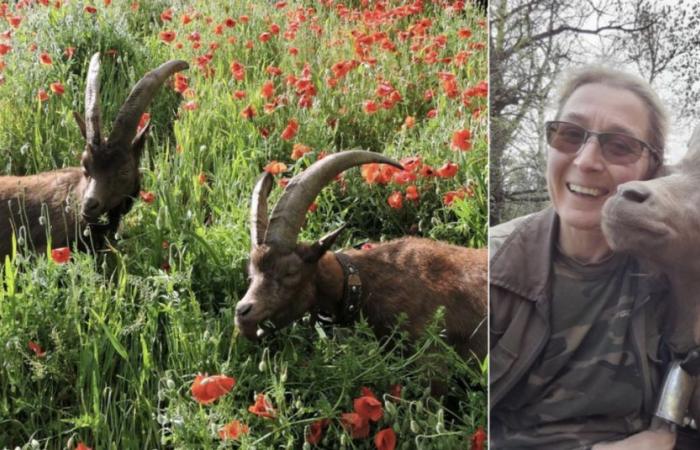
By Sandy Fabiane
Marzia Verona she is a writer and breeder and collaborates on her partner’s small farm in Nus, Aosta. Annalisa Celant she is a dairy farmer, in the summer she manages the Costa Cervera hut with her family, on the Cansiglio-Cavallo ridge, and in the winter she has a dairy farm in Polcenigo: after Caterina De Boni, others two mountain women tell us about their work, amidst climate change and bureaucracy.
Drought, little fodder and parasites among the consequences of climate change
“One of the most relevant aspects today – explains Verona – is certainly the climate change. This year there have been very strong temperature changes and the animals are also affected: although they can graze even in winter, it must be considered that, when there are no leaves to provide shade and food is scarcer, the sun and high temperatures make them suffer a lot.
Two years ago we had big drought problems instead, especially due to the difficulty in finding pastures and watering the animals. Normally we are self-sufficient in fodder, but in recent years we have had to purchase it at a considerable cost, given that the problem was widespread. Furthermore, the absence of grass and water can cause a delay in the ascent to the mountain pastures or an early descent while the prolonged heat causes a delay in the goats’ heat, which affects the management of the farm.
Then there is the matter of parasites, which are much more present and difficult to eradicate. Here, for example, there is a problem with midges called blackflies, which have been present for some years even at higher altitudes and which pinch cattle on one side, causing anaphylactic shock and possible death, and on the other the udders of goats which they have just given birth, causing them to bleed and preventing the kids from sucking milk. Unfortunately, veterinary treatments do not completely solve the problemperhaps due to the amount of midges present.
There are therefore many small and large consequences: we are not at the levels of Southern Italy, where the situation is more critical, but we are still walking on a razor’s edge.”
…but there is still little awareness
Despite all this, perception of climate change remains limited. Marzia participated in the Pastoralp project, interviewing shepherds and breeders to investigate their perception of the phenomenon: “We wanted to understand if they were putting into practice strategies, or what they believed should be implemented, to deal with it. However, a tendency to deny it emerged: most showed poor perception, in my opinion due to the fact that the problem is so big that it involves an upheaval, so perhaps it is better to deny it because dealing with it is beyond the individual’s reach.”
Aid especially to large companies: little focus is placed on quality
The production of quality mountain products, however, is mainly affected by lack of maintenance of the territories and little attention to small companies. “Most of the aid – claims Verona – is unfortunately intended for the largest companies. Here in Valle d’Aosta the companies are all quite small because the territory is small and the main production is linked to fontina, which is a DOP, therefore with many constraints.
Nonetheless, it still happened that we were excluded from measures that had been designed at a territorial level, as 30 goats and 20 cattle were not included in the numbers necessary to have access to funding. In fact, however, it is the small companies that take care of the area, yet the aid also ends up in the wrong hands due to speculation on the mountain pastures. The problem is that we work on numbers, whether of animals or hectares, and not on quality and the consequences are multiple, starting from the cleaning and arrangement of pastures which large companies are unlikely to take care of.”
More staff training and culture of quality products
The situation is also similar on the opposite side of the Alps. “Personally – explains Celant – I am lucky enough to have a tradition and bases from which to start, however there is no shortage of difficulties. The main one concerns the lack of investments: I produce a typical traditional product, the mountain cheese which has become a garrison slow food, and I can do it because I work in an equipped room where it was historically produced, but the conditions in general are not easy, from the scarcity of water to the lack of electricity and the failure to maintain roads.
Furthermore, it is difficult to sell the products: I had to open a dairy in the village, but it is not easy to close the circle with the costs or sell everything, because people travel mostly at the weekend and generally to eat, not to buy.
The culture of these products has been lost a bit and there is certainly a lack of projects that make known the importance of this economic sector: in our small way we can do little, we are unable to make ourselves known to the point of having that satisfaction that contributes to maintaining the activity.
One of the solutions is integration with other businesses. For example, with the cultivation of valley cereals I have made our agricultural beer and I process milk at 360 degrees, from soap to milk liqueur, which although not agricultural products, complete the offer. If we found trained staff we could integrate further, but we cannot find trained people to spend the season in a remote place and I cannot afford to invest in training independently.
It is therefore a whole chain and we are in difficulty for a series of things. I am trying different solutions, using all the dynamism I feel I possess, but in recent years it has been difficult to move forward with a certain balance. Greater valorization of these products would be needed, while often economic purposes different from ours prevail, which are ethical, environmental, territorial and linked to something difficult to describe.”



